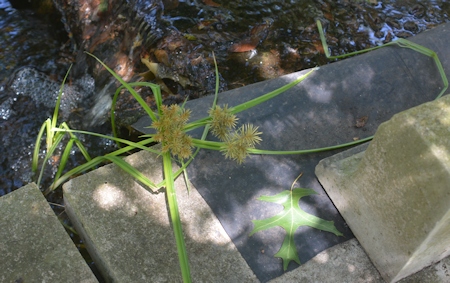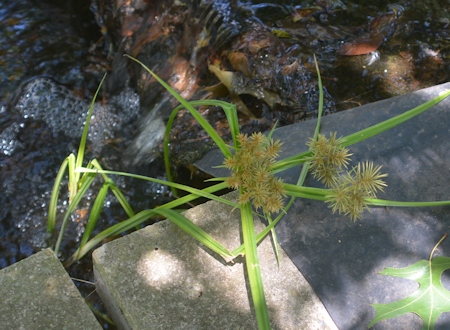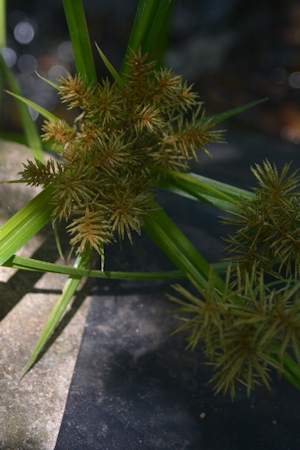R- brought back a sedge that neither of us had seen before. We don’t have a field guide to sedges (if one exists) but we do have books that include *some* sedges. Correll & Johnston, the huge (old now) Manual of the Vascular Plants of Texas should have all of the Texas sedges, but a) sedges aren’t easy to ID for the amateur and b) Correll & Johnston made no effort to ease the amateur’s way. Either you suck it up and learn all the terminology or…you don’t. No pictures, no hints. And there are LOTS of sedges. And c) Carex (the biggest of the sedge genera) is the largest vascular plant genus in North America. There are a LOT of sedges and a LOT of Carex species.
There is a newish (new because between 2006 and now it’s up to 21 editions of itself) visual key for Carex, which I just discovered via another website, and have spent a happy hour and a half (so far) playing with. Did not get our new find IDed, but did have a blast looking at one of the smartest trickiest photo presentations ever. An entire screen of tiled tiny-tiny images…and a scroll bar to enlarge any of them as large as you want. If you want to take a look, the main site isn’t…um…completely intuitive, but when you get to the images themselves…wowza! It includes exquisite botanical illustrations as well as good photos, from the habitats where the illustrated species are found to the details of a given sedge. http://www.herbarium2.lsu.edu/aba/#%7B%22filters%22%3A%7B%7D%2C%22search%22%3Anull%2C%22sortBy%22%3A%22Species%22%2C%22view%22%3A%22grid%22%7D is a place to start. There’s a horizontal scaling bar in the upper right part of the image, above the tiled field of thumbnails. To the right, the images get larger; they start at the far left. On the left a vertical sidebar allows you to pick a state in the US.
And now for my images of the one R- found, brought back, and stuck in the lily pond so it might survive another day or so for more measurement and photography, though I’m hoping to walk down to the “swamp overflow” in the south creek woods and take some in situ. I wish we had the rainfall to sustain a little real wetland. We no longer have the energy to build another rain barn to supply one. This plant got “floppy” in the leaves while being carried home on a hot afternoon; the leaves are 1 cm wide, and the inflorescence starts about 50 cm. from the base, which here is submerged about 7 inches in the lily pond. I’m not even sure it’s a Carex sedge (there are other genera) but that’s the most numerous…and there’s always more to learn.




I am now crazy about this sedge and want it to live here always…which in the alternating drought-flood-heat-freeze climate we have may not work, but I will try to find a way. It’s stunningly beautiful.

That’s supposed to be a link. It looks like a link in the edited version but not here. Time for copy/paste.
The sedge, whether Carex or not, is beautiful. Enjoy your search for it’s identity and I hope you can provide it with suitable conditions.
I do have a guide to sedges and grasses, but of the UK and Western Europe, one of the Colllins series of field guides.
Jazzlet, I hope we see it again next year. And since I’ve been pointed at the correct genus (not Carex but Cyperus) there’s a slim chance I can figure it out for myself.
Hi – hope everyone is safe and sane. Is this the sedge that Paks tell the girl to use to clean her scabbard? I am continously impressed by the great variety of plants in nature. Enjoy the fall.
Jonathan up here in rainy New Hampshire. I would mail you some rain, but CJ Cherryh needs it more.
HiJonathan….no, this is the first time I’ve seen *this* sedge. I was envisioning a smaller, denser sedge of the kind I see more often.
Elizabeth, I passed your sedge puzzle along to my sister-in-law, ho is a retired professor of botany and collections manager for the Jepson Arboretum at Berkely. She says, “Related genus: Cyperus, not Carex. At least fewer species to deal with, though I still won’t try on images alone.”
Thank you, Jim! I wondered if I had the right genus, and am glad to know I was a) wrong and b) now know it’s a Cyperus-something. Back to Correll & Johnston, though I don’t expect to nail this one on my own. Correll & Johnston’s descriptions, without any hint of what word means what, are opaque as the mud this sedge was growing in. I did measure the parts I knew to measure: total height in the range of 70-80cm, leaves 1 cm wide but look narrower (I had a meter stick). Green is not a dark green, but a medium to lighter green. Growing in mud, in partial sun. Due to medical appointments, haven’t been able to get to the location with the better camera; or to do more measurements. (Please thank your sister-in-law for me; I appreciate her taking the time. I’m aware of the Jepson Arboretum, some of whose images showed up in the LSU’s fancy Carex site with the addictive “scale” tool.)
I hope we get enough rain this coming year for these plants to come back again.
https://plants.ifas.ufl.edu/plant-directory/cyperus-odoratus/
Cyperus odoratus perhaps
‘tho it is doing in Texas is anybody’s guess.
Thank you! I had just found Cyperus ordoratus in an online reference of riparian plants in the Nueces basin and wondered–we’re north of that, actually I think in the Brazos. Another opinion on the sedge is welcome.